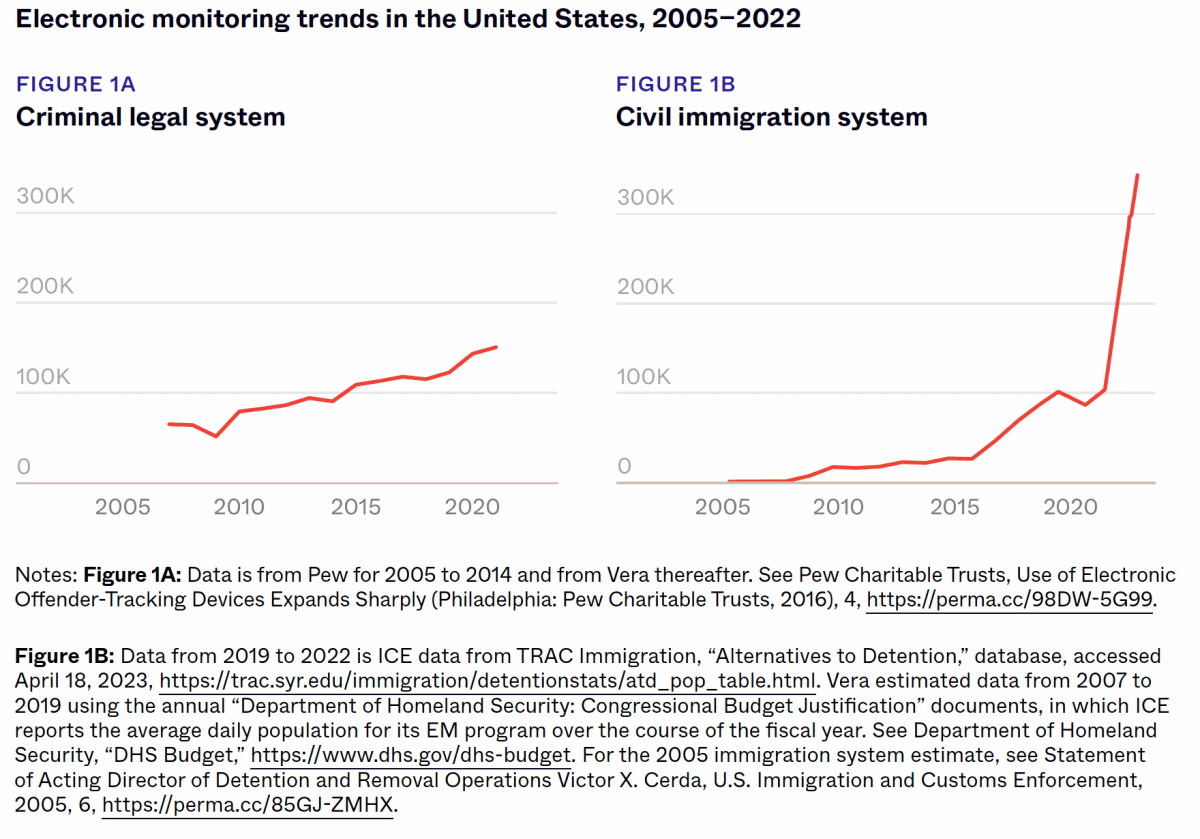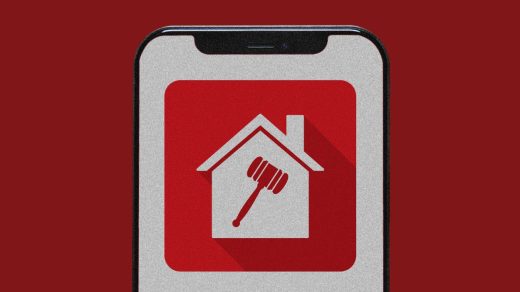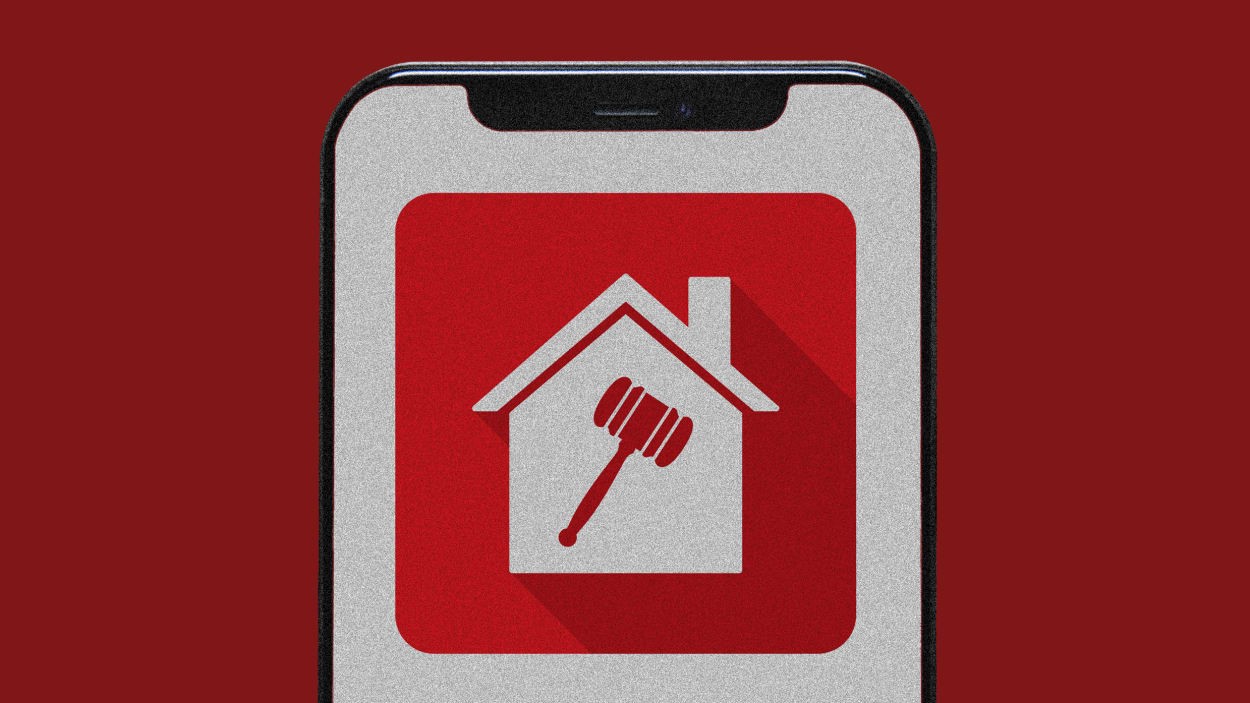Ankle monitors and iPhone apps: New data reveals just how huge America’s digital jails have become
In the early days of the pandemic, as courts across the country shut down and people awaiting trial for criminal charges languished in jail, Iman Freeman got a phone call from a local attorney that stunned her.
At the time, Freeman’s nonprofit, the Baltimore Action Legal Team or BALT, was running a bail fund for people in the city who couldn’t afford to post bail on their own. But the attorney didn’t need help bailing his client out of jail. Instead, he told Freeman that, because of COVID, his client had been given the option of waiting out his trial at home—if, that is, he could afford the roughly $300-per-month ankle monitor supplied by a private, for-profit company.
Though Freeman, who is also an attorney, was repelled by the proposition—pushing the cost of a pricey surveillance device, which she calls “the box,” on to people who couldn’t afford it—she agreed to pay the fees. “Basically you’re saying: either go to jail during a pandemic or pay $10 to $17 a day to be on the box,” she says.
Little did Freeman know, that client was only the beginning. Before long, the number of people in Baltimore who were struggling to pay for their own ankle monitors had ballooned so rapidly that BALT established an emergency fund to cover their fees. In less than two years, the organization spent about $300,000, doled out monthly in stacks of cash. “This was the very definition of criminalizing poverty to me,” she says.
But Baltimore was hardly alone. An expansive new report released Tuesday by the Vera Institute of Justice estimates that the number of people on electronic monitoring has more than tripled since 2015 and grown tenfold since 2005, swelling to nearly half a million people in 2022. That growth has been driven by a steady increase in the use of electronic monitoring in the criminal justice system and an even more staggering spike in its use by immigration officials: Between 2021 and 2022 alone, the number of people placed on electronic monitoring by Immigration and Customs Enforcement more than tripled. Since 2005, it’s grown 270 times over.

“This is the expansion of control over people that would otherwise be unsupervised,” says Jacob Kang-Brown, a senior research fellow at Vera who coauthored the report with Vera research analyst Jess Zhang.
Stories of the rise of electronic monitoring in America have been emerging out of cities like St. Louis, Chicago, and San Francisco since even before the pandemic began, with local officials touting ankle monitors and smartphone apps as a way to keep people out of jail. But Vera’s findings reveal a more complex picture. While it’s true that the growing use of electronic monitoring in the U.S. has coincided with an overall decline in incarceration, those two trendlines aren’t always linked. In fact, the Vera researchers found, in 2021, the majority of counties with electronic monitoring rates higher than the median also had jail populations above the median. Take a city like Detroit: Between 2020 and 2021, the researchers found, the number of people on electronic monitoring increased by 41%, even as the number of people sitting in jail on any given day increased by 60%. Though the technology is framed by its proponents as a tool for criminal justice reform, the Vera report suggests it’s often used instead to expand the carceral state.
“This number of people could not have been accommodated by the local jail infrastructure,” Zhang says. “So there’s this argument that if [electronic monitoring] wasn’t introduced in a jurisdiction, there would be no other choice except to have these people be entirely free of surveillance.”
Part of the challenge of studying electronic monitoring in America is that there are no national reporting requirements like there are in other parts of the justice system. Compounding matters, the courts, government agencies, and private companies operating these programs are deeply fragmented. Until now, the most recent data came from a 2015 Pew report. The Vera researchers spent five years individually contacting all 50 states and some 800 counties, eventually collecting data from more than 500 of them, as well as the federal courts, Federal Bureau of Prisons, and ICE. The final report—which is based on that data and estimates extrapolated from that data—represents the most comprehensive look to date at the true size of this fast-growing, heavily privatized industry.
ICE is responsible for the vast majority of the industry’s growth, with some 360,000 people placed on electronic monitoring in 2022. As record numbers of people have crossed the southern border, the Biden administration has faced escalating pressure, particularly on the right, to track anyone who isn’t being held in detention centers. The combination of those two factors has led to an unprecedented explosion of immigrant surveillance, even for families seeking asylum. One company in particular, the private prison giant GEO Group, has an exclusive $2.2 billion contract as part of ICE’s “alternatives to detention” program, through which it provides both GPS trackers and a monitoring app called SmartLINK.
The ready availability of this technology—particularly SmartLINK—has made it easier than ever for ICE to conduct “24-hour suspicionless surveillance” of people who otherwise would likely have been released on their own recognizance, says Naureen Shah, deputy director of government affairs at the ACLU’s Equality Division. “The problem always was that it wasn’t really functioning as an alternative to detention. It was just enlarging the subset of people that ICE was keeping tabs on,” Shah tells Fast Company.
She notes that being under this kind of surveillance has been shown to exacerbate the psychological strain of an already traumatized population and worries that the Biden administration’s embrace of the technology may tee up even harsher uses of it during a second Trump presidency. “What we’re all thinking about right now in the immigration space is: What would a Trump administration do with the tools that a Biden administration might leave them?” Shah says.
ICE did not respond to Fast Company’s request for comment. In a statement, a GEO Group spokesperson said the company “has no role in determining who is placed on agency programs, or for how long participants remain on such programs.” The spokesperson said the company’s goal is to “help government agencies to be more efficient and reduce officer workload.”
Beyond the immigration system, Vera’s research also shines a light on the growing cottage industry of electronic monitoring providers in the criminal justice system. Once dominated by major corrections industry giants, including GEO Group, the field now includes a patchwork of small, local businesses—from bail bonds companies to tiny sole proprietors to counseling centers that have also landed lucrative electronic monitoring contracts.
These for-profit companies operate in a mostly unregulated environment, charging people for their own monitoring and often threatening them with jail time if they miss a payment or experience technical difficulties with the app or monitor. And unlike with bail funds, the money these companies charge is nonrefundable, even if the underlying charges that landed someone on electronic monitoring are ultimately dropped.
Phil Telfeyan, a former attorney for the Department of Justice and executive director of the nonprofit Equal Justice Under Law, has filed several class action suits since 2015, accusing local officials and the companies they work with of extorting probationers and pretrial arrestees. Telfeyan says the vast majority of his clients are facing misdemeanor charges and wind up having their cases dismissed, only to be left in dire financial circumstances due to electronic monitoring fees. Others, he says, have pleaded guilty just to get out from under the fees. Several of Telfeyan’s clients have testified that they’ve been driven from their homes, unable to pay for rent and their electronic monitoring. Another, he says, had a habit of sleeping by an electrical outlet, for fear that his ankle monitor would die overnight.
“‘Prison without bars’ is the phrase we hear from a lot of clients,” says Telfeyan.
The companies on the other side of these suits argue they are ultimately performing a public service, both for their local communities and the people they’re monitoring. “We are the last resort before you go to prison for a lot of people,” says Danny Koester, owner of ABK Tracking, an Evansville, Indiana-based firm that was the target of one of Telfeyan’s suits, which is currently pending appeal. “People want them accountable.”
And yet, Telfeyan says it’s “a myth” that everyone on electronic monitoring would otherwise be in jail if the technology weren’t so ubiquitous. “I don’t see it as reducing the jail population,” Telfeyan says. “I see it as simply applying to people who were very likely to have been released in a prior world, but now are just released with this expensive ankle monitor.”
Freeman says she’s unsure how many of the recipients of the electronic monitoring fund in Baltimore ultimately had their charges dropped. After two years of operations, BALT exhausted funding for the electronic monitoring program and was forced to shut it down. At that point, most of the more than 200 people it served were still awaiting their day in court. And yet, BALT’s own research on the bail system is telling: In 2019, 70% of people who were held in jail without bond ultimately had their charges dropped.
Kang-Brown and Zhang of Vera argue that, at the very least, the use of electronic monitoring needs substantially better oversight, including a national reporting standard similar to the annual surveys of jails, probation, and parole that the Bureau of Justice Statistics already conducts. But more than that, they argue that the lack of transparency and oversight in the current system means private companies should not be deputized to run electronic monitoring programs at all.
“In many cases, being on electronic monitoring can create many of the same harms as being in jails and prisons,” Zhang says. Introducing a profit incentive to that system, the researchers argue, can only make those problems worse.
(14)



